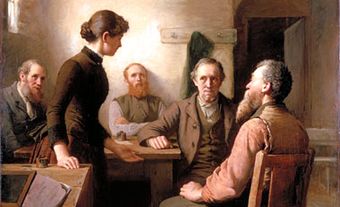Higher Education
Higher education usually refers to education and training in universities, colleges and institutes of technology or art. It also refers to an academic field of studies, which has been advanced in Canada since 1969 with the establishment of a graduate unit at the UNIVERSITY OF TORONTO. Today at least eight universities offer degrees and other credentials in higher education. Operating at the graduate level, higher education programs typically offer preparation for academic, administrative, policy, and leadership careers.
What would now be called higher education was first organized by the churches in the 17th century (seeHISTORY OF EDUCATION), but it was not until 1789 that the first "church-sponsored" UNIVERSITY, UNIVERSITY OF KING'S COLLEGE (NS), was founded in Canada. MCGILL UNIVERSITY (founded in 1821) was the first private nondenominational university to receive a charter. The establishment of provincial universities began with the University of Toronto in 1850. The ROYAL MILITARY COLLEGE OF CANADA, operated by the federal government, opened in 1876.
The universities' chief functions are teaching, research and community service. Programs of study leading to bachelor's, master's and doctoral degrees are offered in the arts and sciences and in the professions. There are 95 degree-granting institutions of higher education, mostly universities, affiliated to the Association of Universities and Colleges of Canada. Until the mid-1960s, post-secondary vocational education was provided by a variety of specialized institutions. At that time, systems of colleges were introduced, mostly by provincial governments. In some cases the colleges absorbed former institutions of post-secondary education (PSE). Such non-university institutions are called by a variety of names including college, COMMUNITY COLLEGE, regional college, college of applied arts and technology, COLLÈGE D'ENSEIGNEMENT GÉNÉRAL ET PROFESSIONNEL (CEGEP), institute of technology, and polytechnics. These colleges for the most part offer programs leading to diplomas rather than degrees. Some provide academic education for transfer to university and almost all provide vocational training, covering a vast array of occupations, while others offer both academic and vocational programs; most provide a wealth of community services. There are 128 colleges affiliated to the Association of Canadian Community Colleges.
Enrollment in PSE has risen steadily since the Second World War and the participation rate is over 35% (the participation rate is defined as the total of full-time students in PSE as a percentage of the population 18-24 years old). Full-time students in universities and colleges are estimated at around 1.4 million; of these, 882 000 attend university. An additional 321 000 and 191 000 part-time students attend university and college, respectively. According to Statistics Canada, about 25% of the population aged 25-64 has a university degree and another 25% has a college or trade school certificate or diploma.
PSE is funded primarily by governments, but private sources of funding, including tuition, have steadily increased in recent decades. Both the provincial and federal governments contribute, but in the context of overall federal-provincial fiscal arrangements the federal share is being constantly renegotiated (see alsoEDUCATIONAL OPPORTUNITY).
Recurrent issues in higher education include who should be served; how good teaching can be assured; how underrepresented groups can be better supported; how costs should be shared by the student and society; what the respective roles and responsibilities of institutions and governments should be; how co-operation with business and industry can be encouraged; and whether aims and outcomes are commensurate.

 Share on Facebook
Share on Facebook Share on X
Share on X Share by Email
Share by Email Share on Google Classroom
Share on Google Classroom


